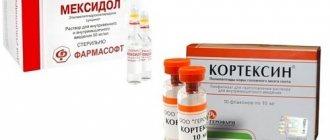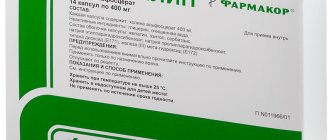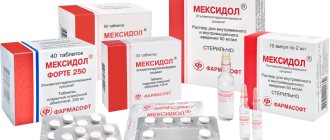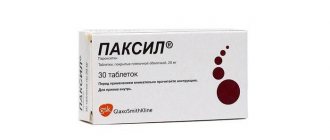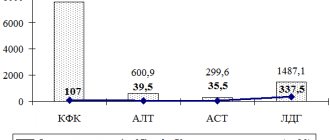Mexidol tablets: indications for use
Mexidol instructions recommend use for:
- consequences of acute cerebrovascular accidents, including after transient ischemic attacks, in the subcompensation phase as preventive courses;
- mild traumatic brain injury, consequences of traumatic brain injury;
- encephalopathies of various origins (dyscirculatory, dysmetabolic, post-traumatic, mixed);
- autonomic dystonia syndrome;
- mild cognitive disorders of atherosclerotic origin;
- anxiety disorders in neurotic and neurosis-like conditions;
- coronary heart disease as part of complex therapy;
- relief of withdrawal syndrome in alcoholism with a predominance of neurosis-like and vegetative-vascular disorders, post-withdrawal disorders;
- conditions after acute intoxication with antipsychotic drugs;
- asthenic conditions, as well as for the prevention of the development of somatic diseases under the influence of extreme factors and stress;
- exposure to extreme (stress) factors.
Mexidol, 50 pcs., 125 mg, film-coated tablets
Mexidol® is an inhibitor of free radical processes, a membrane protector with antihypoxic, stress-protective, nootropic, anticonvulsant and anxiolytic effects. The drug increases the body's resistance to the effects of various damaging factors (shock, hypoxia and ischemia, cerebrovascular accidents, intoxication with alcohol and antipsychotics (neuroleptics).
The mechanism of action of Mexidol® is due to its antioxidant, antihypoxic and membrane protective effects. It inhibits lipid peroxidation, increases the activity of superoxide dismutase, increases the lipid-protein ratio, reduces membrane viscosity, and increases its fluidity.
Mexidol® modulates the activity of membrane-bound enzymes (calcium-independent phosphodiesterase, adenylate cyclase, acetylcholinesterase), receptor complexes (benzodiazepine, GABA, acetylcholine), which enhances their ability to bind to ligands, helps preserve the structural and functional organization of biomembranes, neurotransmitter transport and improve synaptic transmission.
Mexidol® increases the content of dopamine in the brain. Causes an increase in compensatory activation of aerobic glycolysis and a decrease in the degree of inhibition of oxidative processes in the Krebs cycle under hypoxic conditions with an increase in the content of ATP and creatine phosphate, activation of the energy-synthesizing functions of mitochondria, stabilization of cell membranes. The drug improves metabolism and blood supply to the brain, improves microcirculation and rheological properties of blood, and reduces platelet aggregation. Stabilizes the membrane structures of blood cells (erythrocytes and platelets) during hemolysis. It has a lipid-lowering effect, reduces the content of total cholesterol and LDL.
The anti-stress effect is manifested in the normalization of post-stress behavior, somatovegetative disorders, restoration of sleep-wake cycles, impaired learning and memory processes, reduction of dystrophic and morphological changes in various structures of the brain.
Mexidol® has a pronounced antitoxic effect in withdrawal symptoms. It eliminates the neurological and neurotoxic manifestations of acute alcohol intoxication, restores behavioral disorders, autonomic functions, and is also able to relieve cognitive impairment caused by long-term use of ethanol and its withdrawal.
Under the influence of Mexidol®, the effect of tranquilizing, neuroleptic, antidepressant, hypnotics and anticonvulsants is enhanced, which makes it possible to reduce their doses and reduce side effects.
Mexidol® improves the functional state of ischemic myocardium. In conditions of coronary insufficiency, it increases collateral blood supply to the ischemic myocardium, helps maintain the integrity of cardiomyocytes and maintain their functional activity. Effectively restores myocardial contractility in reversible cardiac dysfunction.
Mexidol injections: indications for use
Advertising:
Mexidol has a wide range of therapeutic effects. The drug is prescribed by narcologists, neurologists, psychiatrists, therapists and other doctors. Main indications:
- Acute or chronic diseases characterized by insufficient blood flow to the brain.
- Traumatic, metabolic or toxic damage to the central nervous system. The drug is also used at the rehabilitation stage.
- Autonomic nervous system disorder. Mexidol is prescribed for vegetative-vascular dystonia.
- Treatment of cognitive complications of atherosclerotic brain damage, accompanied by decreased memory and intelligence.
- Acute disruption of blood flow to the heart muscle. Restoration of the cardiovascular system after a heart attack.
- Chronic cardiac ischemia. Used as an addition to main therapy.
- Mental illnesses of the neurotic spectrum, manifested by anxiety, sleep disturbances and decreased mood.
- Consequences of the effects of alcohol, antipsychotics and other substances on the brain. The medicine relieves withdrawal symptoms.
- Acute inflammatory or infectious processes in the abdominal cavity. Prescribed together with other medications.
Mexidol is also used to prevent the development of somatic and mental illnesses if a person is exposed to chronic stress.
An antifungal agent that has a highly specific effect, inhibiting the activity of fungal enzymes dependent on cytochrome P450. Blocks the conversion of lanosterol from fungal cells into the membrane lipid - ergosterol; increases the permeability of the cell membrane, disrupts its growth and replication. Read more in the article: “how to take fluconazole: indications for use.”
Why are injections prescribed?
Mexidol (5 or 2 ml) is useful for blood vessels. During the period of use, there is a restoration of blood flow in the affected tissues and an increase in the elasticity of the walls. If a patient is given injections (2 ml) for psycho-emotional disorders, the antidepressant effect is characterized by:
- reducing the severity of morphological and dystrophic disorders in the brain;
- memory improvement;
- improving learning ability;
- restoring sleep;
- relief of signs of psychogenic type pathologies;
- restoration of behavioral reactions.
Mexidol can be administered to patients in a withdrawal state. The syndrome develops after alcohol abuse. The benefit of the drug is due to its ability to have a beneficial effect on the functioning of the brain. Mexidol injections are prescribed for asthenic syndrome, helps with blood pressure and treats neuroses. For prevention, the medication is prescribed to relieve the symptoms of certain somatic pathologies. Main indications for use:
- intoxication caused by taking psychotropic drugs;
- post-withdrawal and pseudoneurotic disorders caused by systematic abuse of alcoholic beverages;
- ischemia;
- constant feeling of anxiety;
- encephalopathy caused by post-traumatic or dyscirculatory disorders;
- traumatic brain injuries;
- acute circulatory disorders in the brain.
The use of the drug is possible for vegetative-vascular dystonia.
Inhalations have been replaced by new methods and drugs that are much more effective in fighting various diseases. One of these modern means is inhalation therapy using a nebulizer. Read more in the article: “which nebulizer to choose for inhalation.”
Indications for the use of intramuscular injections
Advertising:
The instructions for using Mexidol say that the injection solution is used in the treatment of open-angle glaucoma of various stages, in case of acute myocardial infarction (from the first day Mexidol is connected to a complex therapy regimen). For purulent-inflammatory processes of the abdominal organs, acute inflammation of the pancreas, necrotizing pancreatitis or peritonitis, injections are especially effective. The following is a more detailed list of indications for the use of Mexidol injections:
- acute cerebrovascular accidents;
- traumatic brain injury, consequences of traumatic brain injury;
- encephalopathy;
- autonomic dystonia syndrome;
- mild cognitive disorders of atherosclerotic origin;
- anxiety disorders in neurotic and neurosis-like conditions;
- acute myocardial infarction (from the first day) as part of complex therapy;
- primary open-angle glaucoma of various stages, as part of complex therapy;
- relief of withdrawal syndrome in alcoholism with a predominance of neurosis-like and vegetative-vascular disorders;
- acute intoxication with antipsychotic drugs;
- acute purulent-inflammatory processes of the abdominal cavity (acute necrotizing pancreatitis, peritonitis) as part of complex therapy.
The cheapest similar products
If you need to find a cheaper drug, you should pay attention to such drugs as: Mexicor, Armadin, Glycine, Astrox, Mexiprim. In some cases, analogs that are cheaper than Mexidol may be more effective than the main drug or completely identical in action.
Mexicor
Mexicor belongs to the group of cardiac drugs that affect cardiomycytes by inhibiting free radical processes. These processes occur during ischemia and necrosis of the heart muscle, and lead to disturbances in the contractile and excitatory functions of the myocardium.
Mexican action
Mexicor, acting as an antioxidant, helps preserve the cardiomyocyte membrane and stimulates the formation of enzymes necessary for its adequate functioning. It has a beneficial effect on metabolic processes in the myocardium:
- improves contractility of the heart muscle;
- increases coronary blood circulation;
- promotes the inclusion of compensatory mechanisms;
- stabilizes blood circulation in the brain basins.
Mexicor also improves cognitive abilities, which began to deteriorate due to vascular disorders, and has a positive effect on learning and memory.
The drug is prescribed in the form of capsules of 100 mg in 3 doses per day, or by injection twice a day. The medicine may cause insomnia or drowsiness, digestive tract disorders, allergic reactions, coordination problems, anxiety, irritability, swelling, and weakness. Not for use in children under 18 years of age.
Armadin
Armadin is an inhibitor of free radical processes in the body, as well as a protector of cell membranes. The drug improves the electrical activity and contractility of the myocardium during ischemia, and in addition:
- stimulates compensatory mechanisms;
- increases resistance to pathological processes;
- improves metabolism in the brain;
- reduces the level of low-density lipoproteins, which lead to atherosclerosis.
Biochemical basis of the action of Armadin
Indications for use are:
- traumatic brain injuries;
- vegetative-vascular dystonia;
- acute myocardial infarction;
- open-angle glaucoma;
- intoxication with psychoactive substances.
Not prescribed if the patient has renal or liver failure. May cause nausea, vomiting, diarrhea, drowsiness, palpitations, discomfort in the heart area. Before intravenous administration, 50 mg of Armadin is diluted in 200 ml of physiological NaCl solution.
Glycine
Glycine is a nootropic drug that improves cerebral circulation and therefore stimulates cognitive abilities. The main indication for use is a decrease in cognitive functions due to ischemic disorders, i.e. the drug may improve initially reduced levels of memory and learning. If there were no violations, the drug will not affect cognitive abilities in any way.
Properties of Glycine
Glycine is administered parenterally or sublingually. The maximum daily dose is 300 mg. Children over three years old are prescribed 1 tablet 2-3 times a day. Can be used as an additional remedy in the treatment of alcohol dependence, 1 tablet three times a day.
Astrox
Astrox is an antioxidant drug that is used as part of complex therapy for:
- neurocirculatory dystonia;
- cerebrovascular disorders;
- intoxication with psychoactive substances;
- encephalopathies.
Cardiopsychoneurosis
Contraindications for use: pregnancy, lactation, liver failure, hypersensitivity to the active substance. Treatment begins with a minimum therapeutic dose of 50 mg, and then increases until the desired effect is achieved. When administered by infusion, preliminary dilution in 200 ml of physiological NaCl solution is necessary.
May cause decreased salivation, vomiting, cardiac discomfort, rapid heartbeat, decreased ability to work, and irritability. You should not combine taking the drug with performing complex tasks that require increased concentration.
Mexiprim
Mexiprim is a heteroaromatic nootropic antihypoxant and membrane protector. The drug has anti-stress, muscle relaxant and anxiolytic effects, effectively reduces intoxication in the event of acute pancreatitis, and is prescribed for:
- anxiety disorders;
- impairment of cognitive functions;
- relieving withdrawal symptoms in people suffering from alcoholism;
- inflammatory processes in the abdominal cavity.
Pharmacological properties of antioxidants
It is taken orally, in the form of tablets, and is absorbed in the gastrointestinal tract within half an hour. The medicine is prescribed in doses of no more than 700 mg/day. It is excreted from the body in the urine within 4-5 hours after administration. Can increase the effectiveness of antiparkinsonian drugs and anxiolytics. Not for use in combination with other drugs. Symptoms of overdose are observed in the form of:
- hypotension;
- anxiety;
- temperature rise;
- tremor;
- dry mouth;
- headache;
- drowsiness.
For cervical osteochondrosis
Being an inhibitor of free radical processes, Mexidol provides a powerful antioxidant effect. The drug will also help in cases where it is necessary to remove half-life products of degenerative and dystrophic processes in the vertebrae. This effect of the drug is especially relevant for the treatment of osteochondrosis of the lumbar region, where inflammatory, dystrophic and degenerative processes are most severe. In the case of treating the cervical spine, the drug is useful because it has an antihypoxic effect. Simply put, it increases tissue resistance to oxygen deficiency.
Initially, a dosage of no more than 100 mg of the drug is prescribed 1-3 times a day.
If the effect is noticeable in the first two days, then this dosage is maintained throughout the entire course of treatment. If there is no effect or it is barely noticeable, the dosage is gradually increased until a therapeutic effect is achieved.
This is especially true, since such a deficiency often occurs against the background of cervical osteochondrosis. In this case, the posterior parts of the brain are affected, which manifests itself as dizziness and impaired coordination of movements. Mexidol has a certain effectiveness in terms of improving cognitive functions (memory, attentiveness, speed of decision-making). This is also useful for osteochondrosis, since these functions are affected in most patients (if the cervical spine is affected).
Popular substitutes in tablets
Today, not only injectable analogues of the drug Mexidol are produced, but also cheaper drugs with a similar effect in tablets: Actovegin, Glycised, Cavinton, Nootropil and Tenoten. The advantages of these drugs are considered to be an easier route of administration and a long-lasting effect.
Glitsed
Glycised is a domestically produced drug based on glycine. Glycine is a natural inhibitory metabolite, therefore it penetrates well into all human tissues and organs and has a minimum of side effects.
Glicised is used in the treatment of neuroses and neurosis-like diseases, strokes and encephalopathies. Not prescribed for children under three years of age, pregnant women and patients suffering from arterial hypertension. Take the medication 1 capsule 3-4 times a day. For the treatment of sleep disorders, 1 capsule (100 mg) is prescribed 20 minutes before bedtime. Adverse reactions include:
- dyspeptic disorders;
- dermatological manifestations of allergic reactions;
- headache;
- weakness.
Actovegin
The medicine contains a deproteinized hemoderivate, which is extracted from the blood serum of calves. Actovegin improves energy metabolism, the body's resistance to hypoxia and protects nervous tissue from ischemic damage. It is used in therapy:
- dementia;
- peripheral circulatory disorders;
- polyneuropathy (with diabetes);
- vascular diseases (venous trophic ulcer, arterial angiopathy).
Mechanism of action of Actovegin
Side effects: increased heart rate, increased or decreased blood pressure, myalgia, tremor, sensitivity disorders, vomiting, diarrhea, loss of consciousness, acrocyanosis. Actovegin is used intravenously, intramuscularly and orally, with the initial dose being 20 ml and the maintenance dose being 5 ml. For arterial angiopathy, the dose is doubled, and for polyneuropathy, the initial dose is 50 ml. Cases of overdose have not been described.
Cavinton
Cavinton is a medicine with vinpocentine as an active ingredient. The drug is a psychoanaleptic and psychostimulant, improves blood supply to the brain and its metabolism. Used in several areas of medicine:
- Ophthalmology. For the treatment of inflammatory diseases of the choroid and retina.
- Neurology. For vascular pathologies of the brain of various origins (stroke, dementia, encephalopathy, atherosclerosis).
- Otolaryngology. Treatment of hearing loss and tinnitus associated with vascular pathology.
Instructions for use of the drug
Not prescribed for patients with the acute phase of cerebral stroke, severe forms of arrhythmias, as well as during pregnancy and lactation. Can be used simultaneously with Glibenclamide, Hydrochlorothiazide, beta-blockers.
Cavinton is prescribed only intravenously as a bolus at a rate of less than 80 drops/min and must be diluted with a solution for infusion. Intramuscular administration is strictly prohibited.
Nootropil
Nootropil is a nootropic drug containing piracetam. The drug improves brain activity and cognitive abilities, increases memory, learning and concentration. Positively affects the metabolism of nerve cells and the rheological properties of blood. Prescribed for the following pathological conditions:
- Alzheimer's disease;
- withdrawal syndrome in alcoholism;
- psychoorganic syndrome in elderly patients;
- psychoorganic syndrome in children, which is manifested by a decrease in the level of learning;
- sickle cell anemia;
- myoclonus;
- attacks of dizziness.
Action of Nootropil
The dose varies from 20 to 160 mg/kg. For the treatment of ischemic stroke, the standard dose is 4.8 g/day. The most common side effects are:
- nervousness;
- irritability;
- asthenia;
- depression;
- increased drowsiness.
Contraindications to prescribing the medication are: age under 1 year, renal failure and individual intolerance. Use with caution in patients with impaired thrombotic function of the blood, during surgical interventions and massive bleeding.
Tenoten
Tenoten is a homeopathic remedy that has anxiolytic and sedative effects. It has virtually no contraindications or side effects, except for individual intolerance to the active substances.
The drug is used for the complex treatment of neuroses, stress and autonomic disorders and anxiety. Prescribed orally 1-2 tablets 2 times a day. The course of treatment is 1-2 months. The last dose is no later than 2 hours before bedtime.
The effectiveness of the drug is quite controversial, so it is not recommended to use it as monotherapy.
For headaches
Mexidol is a medicine produced by a Russian pharmaceutical company. The main purpose of the medicine is to restore blood circulation to the brain. The main active ingredient is ethylmethylhydroxypyridine. One tablet contains 125-250 mg. This component improves metabolism, cell regeneration and increases resistance to hypoxia. The drug Mexidol has recently been in demand, due to its versatility and effectiveness. Mexidol has an effect at the cellular level.
The active component, entering the body, enters the blood vessels, then spreads to other tissues. The effect of the medicine begins 5-7 minutes after administration. Residual substances are eliminated from the body within 4-6 hours, so up to 4 tablets per day are allowed. Mexidol is mainly prescribed for headaches, but its spectrum of action is much wider. The active ingredient of the drug is multifunctional:
- reduces blood pressure;
- prevents the development of neurological pathologies;
- reduces the likelihood of blood clots;
- improves alertness and visual acuity;
- relieves seizures;
- improves metabolism;
- relieves anxiety;
- eliminates the oxidation of organic compounds;
- reduces cholesterol levels in the blood;
- increases resistance to stress.
According to experts, the main cause of severe headaches is a problem with blood circulation and constant stress. Since Mexidol has a calming effect and normalizes blood flow, after just a week of taking it you feel noticeably better.
Mexidol tablet p/o 125 mg N50 (Vectorfarm)
Antioxidant agent. Pharmacodynamics Mexidol® is an inhibitor of free radical processes, a membrane protector with antihypoxic, stress-protective, nootropic, anticonvulsant and anxiolytic effects. The drug increases the body's resistance to the effects of various damaging factors (shock, hypoxia and ischemia, cerebrovascular accidents, intoxication with alcohol and antipsychotics (neuroleptics)). The mechanism of action of Mexidol® is due to its antioxidant, antihypoxic and membrane protective effects. It inhibits lipid peroxidation, increases the activity of superoxide dismutase, increases the lipid-protein ratio, reduces membrane viscosity, and increases its fluidity. Mexidol® modulates the activity of membrane-bound enzymes (calcium independent phosphodiesterase, adenylate cyclase, acetylcholinesterase), receptor complexes (benzodiazepine, GABA, acetylcholine), which enhances their ability to bind to ligands, helps preserve the structural and functional organization of biomembranes, neurotransmitter transport and improve synaptic transmission. Mexidol ® increases dopamine levels in the brain. Causes an increase in compensatory activation of aerobic glycolysis and a decrease in the degree of inhibition of oxidative processes in the Krebs cycle under hypoxic conditions with an increase in the content of ATP and creatine phosphate, activation of the energy-synthesizing functions of mitochondria, stabilization of cell membranes. The drug improves metabolism and blood supply to the brain, improves microcirculation and rheological properties of blood, and reduces platelet aggregation. Stabilizes the membrane structures of blood cells (erythrocytes and platelets) during hemolysis. It has a hypolipidemic effect, reduces the content of total cholesterol and low-density lipoproteins. The anti-stress effect is manifested in the normalization of post-stress behavior, somatovegetative disorders, restoration of sleep-wake cycles, impaired learning and memory processes, reduction of dystrophic and morphological changes in various structures of the brain. Mexidol® has pronounced antitoxic effect in withdrawal syndrome. It eliminates the neurological and neurotoxic manifestations of acute alcohol intoxication, restores behavioral disorders, autonomic functions, and is also able to relieve cognitive impairment caused by long-term use of ethanol and its withdrawal. Under the influence of Mexidol®, the effect of tranquilizing, neuroleptic, antidepressant, hypnotics and anticonvulsants is enhanced, which makes it possible to reduce their doses and reduce side effects. Mexidol® improves the functional state of ischemic myocardium. In conditions of coronary insufficiency, it increases collateral blood supply to the ischemic myocardium, helps maintain the integrity of cardiomyocytes and maintain their functional activity. Effectively restores myocardial contractility in reversible cardiac dysfunction. Pharmacokinetics Absorption Rapidly absorbed when taken orally. The maximum concentration at doses of 400 - 500 mg is 3.5 - 4.0 mcg/ml. Distribution: Rapidly distributed in organs and tissues. The average retention time of the drug in the body when taken orally is 4.9 – 5.2 hours. Metabolized in the liver by glucuron conjugation. 5 metabolites have been identified: 3-hydroxypyridine phosphate - formed in the liver and, with the participation of alkaline phosphatase, breaks down into phosphoric acid and 3-hydroxypyridine; 2nd metabolite - pharmacologically active, is formed in large quantities and is found in the urine 1 - 2 days after administration; 3rd - excreted in large quantities in the urine; 4th and 5th - glucuron conjugates. T1/2 when taken orally - 2.0 - 2.6 hours. Excretion: Rapidly excreted in the urine, mainly in the form of metabolites and in small quantities - unchanged. The most intensive elimination occurs during the first 4 hours after taking the drug. Rates of urinary excretion of unchanged drug and metabolites have individual variability.
How to take before or after meals?
Advertising:
Mexidol in tablet form is taken orally. The tablet is not chewed or divided in half. You should drink it with plenty of water. Eating does not have any effect on the activity of the medication, so you can take Mexidol before, during or after meals. The injection form is used for intramuscular injections or intravenous infusions (stream or drip). Before giving the injection, the drug is diluted in a 0.9% sodium chloride solution.
It is injected slowly in a stream over 5 - 7 minutes, drip - at a rate of 40 - 60 drops per minute.
Please note that drowsiness may occur after taking Mexidol, so you should be careful while driving, as well as when engaging in other potentially dangerous activities.
The maximum daily dose for tablets is 800 mg, for injections - 1200 mg. Course therapy is canceled gradually, after achieving a stable clinical and laboratory effect. In case of acute myocardial infarction, as part of complex therapy, it is administered intravenously (the first 5 days) and intramuscularly (the next 9 days) for 14 days against the background of traditional therapy for myocardial infarction, including nitrates, beta-blockers, angiotensin-converting enzyme (ACE) inhibitors, thrombolytics, anticoagulants and antiplatelet agents, as well as symptomatic agents according to indications.
Comparison of release forms
The drug is produced in solid and liquid forms, which have common features and distinctive features. Comparative characteristics will help you decide on the choice of the desired medicinal variety.
Similarities
For all forms of drug release, ethylmethylhydroxypyridine in the form of succinate is used as the active component. This determines the similarity of their pharmacological characteristics, possibilities of use, drug interactions, contraindications and side effects.
The effect of the drug is aimed primarily at improving peripheral microcirculation, stimulating antioxidant mechanisms and increasing the protective functions of cell membranes. The active component is well distributed in tissues. Its metabolization is carried out by the liver, and the main burden of excretion falls on the kidneys.
Mexidol can be used for toxic, traumatic or discirculatory encephalopathy, skull damage, mild brain injuries and more.
Mexidol can be used for both treatment and prevention purposes. Indications for prescribing tablets and injections:
- cerebrovascular disease;
- toxic, traumatic or discirculatory encephalopathy;
- skull damage, mild brain injuries, post-concussion syndrome;
- neuroses, neurotic disorders, increased anxiety;
- dizziness, asthenia;
- cerebral ischemic attack;
- acute and chronic cardioischemia;
- cardiopsychoneurosis;
- neuroleptic poisoning, withdrawal symptoms;
- post-intoxication therapy;
- cognitive impairment due to atherosclerosis, initial stages of dementia;
- high level of stress, mental and physical overload, work in extreme conditions;
- prevention of the consequences of cerebral circulatory disorders.
Any type of drug cannot be used in the presence of high individual sensitivity to its action, intolerance to the auxiliary components, renal or hepatic dysfunction. The activity of the drug has not been sufficiently studied, so it is not used in pediatric practice and is not prescribed during pregnancy and lactation. For bronchial asthma, use with caution.
Both the tablet and injection forms of the drug are well tolerated by most patients. In some cases, side effects are observed:
- nausea;
- dryness of the oral mucosa;
- headache;
- drowsiness or insomnia;
- increased anxiety;
- unusual emotionality;
- sweating of palms and feet;
- desynchronization of movements;
- increase or decrease in blood pressure;
- allergic manifestations.
If the dosage prescribed by the doctor is exceeded, undesirable symptoms may intensify. Overdose is eliminated with detoxification therapy.
During treatment, it is recommended to refrain from potentially hazardous activities, including driving, due to the possibility of developing lethargy and problems with concentration.
The course of treatment is determined by the doctor. Dosages and duration of therapy depend on the characteristics of the disease and the patient’s susceptibility to the action of the drug.
https://www.youtube.com/watch?v=eLFTC3rUK_A&t=4s
What is the difference
Mexidol injections are sold in darkened glass ampoules of 2, 5 or 10 ml. They are intended for jet and infusion administration. The solution contains the active substance (50 mg/ml), sodium metabisulfite and injection water.
In the oral version of the drug, the content of the active component is 125 mg (in Forte tablets - 250 mg). Auxiliary filling of the core is represented by lactose monohydrate, povidone and magnesium stearate. The film shell is made of hypromellose, macrogol, triacetin, lactose and titanium dioxide. The tablets are packaged in blister packs of 10 pcs.
There is also a difference in pharmacokinetic parameters. The tablets do not act immediately, because first they need to dissolve in the digestive tract and be absorbed into the blood. At the same time, they remain in the body longer (about 5 hours, while with parenteral administration, elimination occurs within 1-1.3 hours).
Adverse symptoms when using different forms of Mexidol are similar, but in addition to it, dyspeptic symptoms may be observed when taken orally, and local reactions are possible when using injections:
- itching;
- redness;
- swelling;
- rash;
- compaction;
- inflammation due to pathogenic bacteria.
Which is cheaper?
The injection version of the drug is more expensive. The average cost of 125 mg coated tablets is 261 rubles. for 30 pcs. The price of the solution for intramuscular and intravenous administration is from 473 rubles. for 10 ampoules of 2 ml.
Should it be diluted intramuscularly?
Parenteral administration of a pharmacological agent should be carried out exclusively in medical institutions; use at home is unacceptable. It must be administered intravenously or intramuscularly, observing the rules of asepsis and antiseptics. This is necessary to prevent infection.
When used intravenously, the medicine should be administered in a stream, slowly, over 6-7 minutes. For jet administration, dilution with saline is not required. Intravenous drip administration is also allowed, and the medicine should be pre-diluted with saline solution.
No more than 1200 mg of the substance can be used per day. 1 ml of Mexidol ampoule solution contains 50 mg of ethylmethylhydroxypyridine succinate. Intramuscular injections without the qualified supervision of the attending physician can lead to complications (abscesses, infiltrates). Many patients are stopped from taking this drug intramuscularly by the lack of information on how to dilute Mexidol.
Official information states that, when administered by infusion, the medicine must be diluted with a 0.9% solution. Sodium chloride is used as a side effect. Nothing is said about the intramuscular method. Most often, a decision is made to undergo treatment at a district clinic or hospital. Treatment with Mexidol can also be carried out in a private clinic. It is only important that the doctor has previously dealt with this drug.
Actovegin or Mexidol - which is better?
If the question arises of what to replace Mexidol with, then Actovegin is considered the most popular analogue. This is analogous in principle of action, but not in composition. Actovegin is sold in the form of an injection solution. The active substance is a deproteinized hemoderivative of calf blood. 1 ml of solution contains 20 mg of active substance.
Actovegin is prescribed for the following pathologies:
- metabolic disorders in brain tissue;
- diabetic polyneuropathy;
- violation of the condition of peripheral blood vessels;
- radiation and mechanical damage to the skin.
Do not use the drug if:
- edema of the lungs and other tissues;
- anuria;
- heart pathologies;
- intolerance to the components of the drug.
Actovegin may cause side effects:
- allergic skin rashes;
- heat;
- swelling.
What is better to choose – Actovegin or Mexidol? This issue can only be decided by a medical specialist, focusing on what specific disease requires elimination and what the patient’s condition is. The difference in price between the drugs is insignificant; the analogue is slightly cheaper than the original.
Is it possible or not to take Mexidol for oncology?
The drug triggers glycolytic reactions and ensures the oxidative processes of the Krebs cycle during tissue hypoxia, which supports the formation of ATP and creatine phosphate at the required level. Tumor cells are poor in mitochondria (produce energy) and rich in lysosomes (contain a complex of highly active enzymes). These enzymes are capable of digesting proteins, and their uncontrolled release into the cytoplasm of cells leads to self-digestion and cell death. Vitamin C is not involved in the metabolism of cancer cells, but together with vitamins A and E it serves as good protection for healthy cells (the mechanism of natural death of cancer cells in the presence of antioxidants is not considered in official oncology).
Cancer patients and doctors should know that the complex of vitamins A, E and C has a clear direct anti-cancer effect, which manifests itself within 7-10 days after the start of their use.
In cancer patients, the amount of vitamins A and E is reduced by 70%, and vitamin C by 60%. When using antioxidants after surgery, the relapse rate decreases from 80% to 5.7%. With a 15-day course of treatment with antioxidants, the condition of cancer patients, blood tests, and pain disappear significantly. Former cancer patients, and healthy people as well, should take antioxidants constantly and throughout their lives.
Mexidol and alcohol: compatibility
Mexidol is most often associated with alcohol due to the high potential of the drug in the hepatoprotective sphere. Very often you can find a prescription for the use of Mexidol during the treatment of binge drinking. Or rather, those consequences that follow it are treated. For example, withdrawal syndrome. A hangover may also be one of the likely destinations. You need to understand that the drug can only weaken the consequences of negative effects on the body. This does not mean that taking it with alcohol during a binge will relieve you of any negative manifestations.
Advertising:
It is necessary to understand that the compatibility of almost all drugs with alcohol is extremely low. In most cases, the interaction of the active components with the body will be short-lived due to rapid withdrawal, and accordingly, no effect will be provided. Mexidol allows you to stop the consequences of a pathology that already exists, and not protect against future ones. Accordingly, all the drug can do is ease your hangover and eliminate some of the consequences of consuming alcohol-containing products.
Therefore, it is impossible to talk about the compatibility of the drug with alcohol. In addition, its uncontrolled use can lead to various side effects. This has been confirmed by repeated studies.
Side effects and contraindications
The main undesirable effects of the drug include the possibility of inhibition of motor activity, as well as coordination of movements. When tested on laboratory animals, these deviations occurred at a dosage of 300 mg/kg for intraperitoneal injections and 400 mg/kg for oral administration. The most common side effects of Mexidol include the following:
- lack of coordination;
- nausea;
- dry mouth;
- drowsiness;
- fatigue;
- increased anxiety;
- hyperhidrosis;
- dizziness;
- cephalgia;
- allergy.
It should be emphasized that Mexidol is characterized by an extremely low level of toxicity, so the likelihood of adverse reactions is minimized. Before prescribing the drug, the attending physician tells the patient in detail about its main effects, duration of use, and calculates the dosage. In addition, it is necessary to carefully collect anamnesis to establish possible contraindications, which include:
- acute renal and liver failure;
- individual intolerance to the main substance of the drug or its auxiliary components.
Regarding pregnant, lactating and pediatric patients, the doctor decides on the prescription individually, but most often the use of Mexidol in these categories is limited. Prescribed only in cases where the risk of negative consequences may be less than the expected benefit.
Analogs of Mexidol in tablets
Most medications are available in tablets; they have a cumulative effect and are usually prescribed for use 1-3 times a day. Among the most popular analogues of Mexidol in tablets it is worth noting: Phezam, Piracetam, Cavinton, Glycine, Meldonium, etc.
Picamilon
One of the analogues of Mexidol is Picamilon. Picamilon is a vasoactive and nootropic drug that is intended for:
- complex therapy for neuroinfections;
- traumatic brain injuries, neurocirculatory dystonia;
- moderate to mild circulatory disorders.
It is difficult to determine which is better, Picamilon or Mexidol; the prescription must be approached taking into account the individual condition of the patients. Prescribing drug therapy is the responsibility of only doctors.
Mexiprim
Advertising:
The drugs Mexidol and Mexiprim are essentially analogues. They are prescribed to treat the same range of diseases, but they also have some differences. What is the difference between Mexiprim and Mexidol? The first is an analogue, the second is an original. In fact, they are the same both in purpose and in indications and contraindications. The only difference is the method of purification and obtaining the main and additional components.
Piracetam
Another analogue of Mexidol as a nootropic drug is Piracetam. Prescribed for the treatment of intellectual-mnestic disorders.
Instructions for use "Mexidol"
Tablets are taken 1 pc. 2 times a day. This is the minimum dose with which to start treatment. If there are no allergic reactions or other side effects, the dosage can be increased to 4-6 tablets per day. Those. in the future you can take 1-2 tablets maximum 3 times a day.
The total duration of therapy is determined by the disease:
- hangover – 5-7 days;
- drug addiction – 5-7 days;
- ischemia – up to 60 days.
What is better Mexidol or Cavinton
Cavinton and Mexidol have the ability to influence brain activity. However, this action is due to different mechanisms of action. Next, let's try to figure out what the difference between them is. First of all, the drugs have different active ingredients, which causes the main differences: Cavinton, unlike Mexicol, has anticonvulsant, sedative, and anti-stress properties. Of the two remedies, only Cavinton can be prescribed for pathology of the auditory analyzer, since Mexidol does not have similar properties.
However, Mexidol has a wider range of actions, including antioxidant, antidepressant, and anti-intoxication.
They also differ in some indications and contraindications. Mexidol can be prescribed at any stage of a stroke and does not cause “steal” syndrome, when blood flow is more activated in healthy areas of the brain than in affected ones. It is important that this syndrome is typical when Cavinton is used in the acute period of stroke, therefore it is contraindicated in this condition.
Experts' opinions about the effectiveness of drugs are ambiguous; it is quite difficult to compare them, since they have different mechanisms of action. It is not possible to say which remedy is more effective, since each individual organism has a different effect. It all depends on the individual’s tolerance and susceptibility to the medication, as well as the presence of concomitant diseases.
Mexidol and Mexiprim: what is the difference?
The drugs are antioxidants - they prevent the production of free radicals in the body, which damage cells and cause their death. They have an anti-anxiety, nootropic effect - they improve the processes of thinking, memorizing and reproducing information, relax muscles and reduce cramps, increase resistance to stress, weaken the toxic effects of alcohol and antipsychotics - drugs for the treatment of mental disorders. It is not entirely correct to talk about which drug is more effective, since Mexidol and Mexiprim are analogues. The main difference between the first and second drugs is a more complete set of clinical trials that Mexidol underwent before entering the pharmaceutical market.
The requirements for generics are always lower. That is why the effectiveness of the original drug in the treatment of a number of diseases has been confirmed, for which Mexiprim has not been studied at all. Of the two medications, you should choose Mexidol for the following diseases:
Advertising:
- traumatic brain injury;
- IHD;
- open-angle glaucoma;
- peritonitis, pancreatitis.
If we compare the composition of Mexiprim and Mexidol, it should be noted that the latter contains a preservative in ampoules. This increases the risk of developing allergies. Another significant difference between Mexidol and Mexiprim is cost. If this issue is important to you, then it is better to buy Mexiprim - its price is lower by an average of 100-150 rubles.
Reviews
Both tablets and injection solution receive mostly positive reviews from doctors and patients.
Doctors
Yurasevich S. D., psychotherapist, Samara
An excellent drug, effective both for mild neurotic disorders and for neurological diseases. It increases the body's resistance to stress and is suitable for preventing and eliminating chronic fatigue. Both forms are characterized by a mild effect and good tolerance. The likelihood of an overdose is minimal.
Denisova T.N., neurologist, Moscow
A domestically produced drug in tablets and injections. It has proven itself as an effective addition to various therapeutic complexes. Suitable for the treatment of traumatic brain injuries, encephalopathy of various etiologies, ischemic disease, including the chronic form, and many other pathologies and conditions. Can be prescribed to elderly patients.
